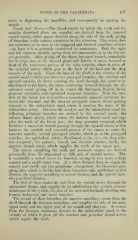Page 397 - My FlipBook
P. 397
TEETH OF THE VERTEBRATA. 407
assist in depressing the mandible, and conseqnently in opening the
mouth.
Vessels and Nerves.—Tlie blood-vessels by which the teeth and the
muscles described above are supplied are derived from the external
carotid artery, which passes forward along the side of the neck, giving
off branches to the various structures in this situation. This artery does
not terminate, as in man, in the temporal and internal maxillary arteries
—at least it is so generally considered by anatomists. Both the right
and left common carotids spring from the innominate, as in the Carniv-
ora generally. After giving off the thyro-laryngeal branch, remarkable
for its large size, to the thyroid gland and larynx, it passes forward in
front of the transverse process of the atlas vertebra, where it gives off
the occipital artery, which goes to the back of the head and the deep
muscles of the neck. Upon the base of the skull in the vicinity of the
carotid canal it bifurcates into two principal branches, the external and
internal carotids, the latter entering the skull through this canal to be
distributed to the brain, the latter continuing forward through the ali-
sphenoid canal, giving off in its course the laryngeal, lingual, facial,
posterior auricular, and superficial temporal branches. Near the con-
dyle of the lower jaw it describes a remarkable sigmoid curvature be-
tween this structure and the internal pterygoid muscle, thence passing
forward to the infraorbital canal, where it receives the name of the
infraorbital artery. Between the condyle and the infraorbital canal the
following principal branches are emitted by this arterial trunk : the
inferior dental artery, M'hich enters the inferior dental canal and sup-
plies the teeth of the lower jaw ; the deep posterior temporal, which
furnishes a masseteric branch passing through the sigmoid notch, or that
between the condyle and coronoid process of the ramus, to enter the
masseter muscle ; several pterygoid arteries, which go to the pterygoid
muscles; the ophthalmic artery, distributed to the eye; the deep ante-
rior temporal ; the palatine, buccal, and alveolar arteries ; lastly, the
superior dental artery, which supplies the teeth of the upper jaw.
The nerves supplying the teeth and accessory organs are derived
principally from the trigeminal or fifth pair of cranial nerves. This
is essentially a mixed nerve in function, arising by two roots, a large
sensory and a small motor root. At a short distance from its origin the
sensory root swells out into ganglionic enlargement, the Gasserian gan-
glion, after which it divides into three branches—the ophthalmic or first
division, the superior maxillary or second division, and the inferior max-
illary or third division.
The first of these makes its exit from the cranial cavity through the
sphenoidal fissure, and supplies by its subdivisions the eyeball, mucous
membrane of the eyelids, the skin of the nose and forehead, dividing into
frontal, lachrymal, and nasal branches.
The second of these branches, the superior maxillary, issues from the
skull through the foramen rotundum, and supplies the side of the nose,
upper teeth, and the upper part of the mouth and pharynx. It crosses
from the foramen rotundum directly to the infraorbital canal, in the
vicinity of which it gives off the anterior and posterior dental nerves
which supply the teeth.


